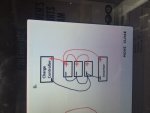Craig.Gorder
New member
Hi there -- I've been running my solar system for a few months now and it seems to be giving me some trouble/anxiety. I have a total of 400ah in my battery bank. However, whenever there is no solar input (e.g. nightime) and I am pulling from the battery bank, the voltmeter drops substantially. I'm not sure if there is an issue here, or I just don't understand what the volmeter represents (it's battery bank life remaining, right?).
For example: My fridge pulls more power than anything else in my rig (about 6-7 amps for about 10 minutes per hour). Before my fridge kicks on, my voltmeter will read 12.7V. As soon as the fridge turns on, it will drop as low as 11.8V. Obviously, this shouldn't be happening, considering that suggests I'm going from 100% battery to 0%. Once the fridge turns off, it will bump back up to 12.7V. It worries me that I am somehow damaging my battery bank and pulling below the 12.2/12.3 range.
A few questions:
1) Is this typical for the voltage meters on other peoples' set ups? It seems like the voltmeter is correlated to the current pull, rather than battery bank remaining. I have two voltage meters in the system, and they both share similar readings. Even my fridge has a voltage display, and that is inline with those voltage meters -- so I assume the three of those are not all off.
2) Is there a better means of actually measuring the percentage left in the battery bank? Or should I just do the rough math in terms of amp hours used? I certainly want to baby my batteries.
3) Do you all think this means something may be messed up in my system? If so, any ideas?
Any help is appreciated! This was my first solar project, so feel free to talk to me like I'm a child
My setup:
4 x 100W solar panels
4 x 100 ah deep cycle AGM batteries
200 amp relay isolator
1000W inverter (although every permonent components go through this, they are all DC)
EPEVER 40A MPPT Solar Charge Controller
My battery wiring is in parallel (I wanted to post some pictures, but I can't seem to get them to upload).
I've also tried the "perfectly balance drain" wiring, but I switched it, fearing that was the cause of the issues. I assume battery wiring isn't the culprit, since both wiring efforts produced the same results.
For example: My fridge pulls more power than anything else in my rig (about 6-7 amps for about 10 minutes per hour). Before my fridge kicks on, my voltmeter will read 12.7V. As soon as the fridge turns on, it will drop as low as 11.8V. Obviously, this shouldn't be happening, considering that suggests I'm going from 100% battery to 0%. Once the fridge turns off, it will bump back up to 12.7V. It worries me that I am somehow damaging my battery bank and pulling below the 12.2/12.3 range.
A few questions:
1) Is this typical for the voltage meters on other peoples' set ups? It seems like the voltmeter is correlated to the current pull, rather than battery bank remaining. I have two voltage meters in the system, and they both share similar readings. Even my fridge has a voltage display, and that is inline with those voltage meters -- so I assume the three of those are not all off.
2) Is there a better means of actually measuring the percentage left in the battery bank? Or should I just do the rough math in terms of amp hours used? I certainly want to baby my batteries.
3) Do you all think this means something may be messed up in my system? If so, any ideas?
Any help is appreciated! This was my first solar project, so feel free to talk to me like I'm a child
My setup:
4 x 100W solar panels
4 x 100 ah deep cycle AGM batteries
200 amp relay isolator
1000W inverter (although every permonent components go through this, they are all DC)
EPEVER 40A MPPT Solar Charge Controller
My battery wiring is in parallel (I wanted to post some pictures, but I can't seem to get them to upload).
I've also tried the "perfectly balance drain" wiring, but I switched it, fearing that was the cause of the issues. I assume battery wiring isn't the culprit, since both wiring efforts produced the same results.




